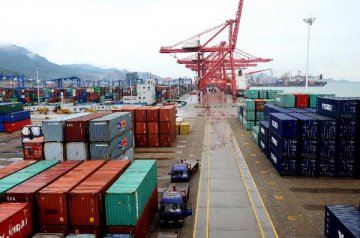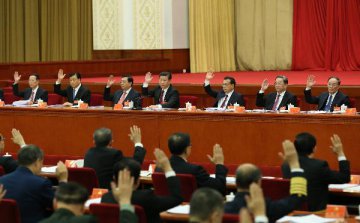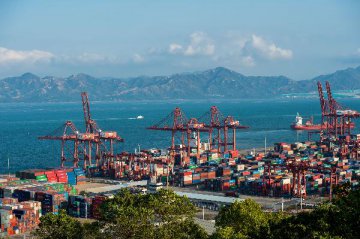
The National Bureau of Statistics (NBS) is going to release the latest data about national economic operation in the middle of April. Several analysts predict that China’s gross domestic product (GDP) may grow by 6.8 percent as China’s economy has seen a good start in the first quarter of 2017, there are more positive factors and signal for economic recovery becomes stronger. Experts said that although there are still uncertainties and economic operation still faces downward pressure, the stable and favorable development will continue in the second quarter.
Prediction: many institutions are positive
Many institutions are positive about the economic operation in the first quarter of this year. According to the Report on Economic and Financial Outlook for the Second Quarter of 2017 recently released by International Financial Institute of Bank of China (BOC), positive factors for China’s economy increase evidently in the first quarter of this year, driving forces for economic growth change from “single engine” to “twin engines”, and prosperity cycle will continue to lengthen.
“Rally in supply and demand boosts production. Development of tertiary industry enjoys a good momentum. Signal for economy recovery becomes stronger. Thus, the GDP is expected to hike by 6.8 percent in the first quarter.”
Lian Ping, chief economist with the Bank of Communications, analyzed that in terms of detailed indicators, three kinds of major investment all climb with infrastructure investment seeing the fastest growth. Exports may grow by 4.5 percent in the first quarter, faster than that in last year, and imports are likely to move up by 20 percent in the first quarter. It is noteworthy that consumption may surge by about 9.6 percent during January and March and its influence on driving economy may weaken.
According to analysis by the International Financial Institute of BOC, the slowdown in consumption growth mainly results from the decline in vehicles with small displacement, policy of collecting purchase tax and subsidy for new energy vehicles and higher base number of last year. But at the same time, emerging consumption and consumption related to housing keep booming, implying that new industries and emerging business types continue to develop faster owing to promotion of supply-side structural reform and influence of entrepreneurship and innovation.
As for this, economist Ma Guangyuan said at the new consumption forum for 2017 held on April 6 that due to the new industries, new business types and new models created by new technologies, emerging consumption grows by more than 40 percent and will influence about 500 million people. As a result, the size of Chinese individual consumption is expected to reach 5.6 trillion U.S. dollars by 2020, which is 1.75 times of that in 2016.
The latest economic statistics also signal economic recovery. Statistics from the NBS showed that both manufacturing purchase management index (PMI) and non-manufacturing commercial activity index climbed to a new high over the past three years. Manufacturing PMI registered 51.6 percent on average in the first quarter, over 2 percentage points higher than that in the same period of last year, said Chen Zhongtao, analyst from China Logistics Information Center. Major sub-indexes all picked up remarkably, indicating improvement in market demand and production activities. Enterprises and industries generally turn better. Economic growth shows growing trend and is expected to reach about 6.8 percent in the first quarter.
“The high-frequency data in March reveals that domestic economy keeps current good momentum. Rate of operation of iron & steel and coke-making enterprises increased. Month-on-month growth of crude steel output and coal consumption of power plants maintained steady. Cement prices in North China, East China and Northeast China rebounded remarkably. As sales volume of vehicles in February picked up significantly, it is predicted that its impact on overall consumption will be weakened gradually.” Xie Yaxuan, chief analyst from China Merchants Securities Co., Ltd., forecasted that various economic data will keep surging in March, economic growth will maintain stable and GDP will see a year-on-year growth of 6.8 percent in the first quarter of this year.
Highlight: recovery in industrial economy beats expectation
Recovery in industrial economy is one of the big highlights of China’s economic operation in the first quarter. Seen from the manufacturing PMI in March, Zhao Qinghe, senior statistician from the NBS, analyzed that production index and new orders index stood at 54.2 percent and 53.3 percent, up by 0.5 percentage point and 0.3 percentage point respectively when compared with that in previous month. Purchase quantity index was 53.4 percent, 2 percentage points higher than that in February. Financial statistics of industrial enterprises, another important indicator reflecting situation of industrial economic operation, also showed a sound trend out of expectation. Total profits of industrial enterprises with annual revenues exceeding 20 million yuan jumped sharply by 31.5 percent in the first two months of this year, 29.2 percentage points and 23 percentage points higher than the growth in last December and 2016 respectively. In addition, industrial production also moved forward steadily. Above-scale industrial added value witnessed a year-on-year growth of 6.3 percent in January-February, an increase of 0.9 percentage point from the same period of last year.
Industry insiders stated that price is the most influential factor driving industrial economy to pick up in the first quarter. After four and a half years of industrial deflation, economic operation got stabilized and recovered, boosting industrial product prices to go up. Manufacturing producer price index (PPI) rose by 0.06 percent in February from previous month and 7.8 percent from a year earlier, representing the highest year-on-year growth since 2008. The NBS is going to release the PPI for March. Several experts indicated that the year-on-year growth of PPI may fall slightly but is likely to stay at about 7.5 percent.
“The PPI’s contribution to revenues is higher than cost’s contribution. At present, the significant rise in PPI is positive to industrial profits.” Macro-economic center of Minsheng Securities Co., Ltd. pointed out in a report that prices of black bulk commodities skyrocketed, while profits of middle and downstream industries (such as mining, smelting manufacturing and chemical industries) directly related with petroleum, coal, black bulk commodity and nonferrous metal accounted for over 30 percent of total profits. Therefore, profits of some industries surged by times during January and February.
Outlook: progress with stability may be achieved in spite of pressure
As for the economic operation in the second quarter, most industrial experts thought that although there are still some internal and external uncertainties which influence the economic operation, the stable and favorable development is supposed to continue.
In the opinion of Lian, the cooling of real estate market may bring pressure to economic growth. Whether growth of investment in real estate development will continue is unknown. The cooling of the housing market will gradually influence consumption in furniture, household appliances and building material. If the growth rate of investment in real estate development slows down, it is difficult to improve manufacturing investment and to boost investment to keep increasing by depending on infrastructure. Uncertainties in international market also exist. Therefore, it remains to be seen whether the economy is able to keep turning better in the second half of this year due to downward pressure.
“The extensive regulation measures on real estate market in many places have adverse impact on investment in real estate, which may appear in the second quarter. It remains to be seen whether improvement in China’s economic fundamentals meets expectation.” said Xie. But he also stated that the further tightened regulations in real estate market cannot beat the expectation that housing prices will continue to rise in the medium and long term and real estate developers won’t change their investment accordingly. Investment in real estate market is likely beat the expectation in 2017 as long as the regulations in the industry don’t involve tightening of monetary policy. Investment will make more contribution to domestic economy this year. Due to recovery in investment demand and improvement in export demand, it is hard for domestic economy to experience a double dip.
In the view of Chen, there are also many favorable factors for economic operation. Chen said that the “Belt and Road” Initiative has gained response and support from more and more countries and predicted that a batch of major cooperation projects will be finalized during an international cooperation forum summit about the “Belt and Road” Initiative to be held in May. This kind of external environment can help domestic enterprises to explore international market. Besides, virtual economy slows down, environment for real economy development is improved increasingly, and effective investment keeps moderate growth, which play an important role in stable economic growth. Therefore, the economic trend with progress and stability will go on in the second quarter.
According to the report by the International Financial Institute of BOC, there are still many uncertainties influencing external environment, endogenous impetus for domestic economic growth is still weak, and sustainable rally in investment is faced with challenges. Meanwhile, with further advance of supply-side structural reform, performance of enterprises will see improvement and emerging industries will enjoy rapid development. The GDP is expected to hike by about 6.9 percent in the second quarter. During the whole year of 2017, the growth will be high at first and then slow down. It is not suggested to introduce more policies of stabilizing economic growth in the near future. In terms of fiscal policy, study on the potential and feasibility of tax reduction should be carried out. Monetary policy should be tightened amid stability and interest rate hike can be considered at proper time.
Translated by Vanessa Chen























Latest comments